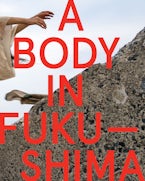- Home
- Wesleyan Dance
- performing arts
- photography
- history
- A Body in Fukushima

A photographic account of an extended solo performance in irradiated Fukushima between 2014 and 2019
On March 11, 2011 one of the most powerful earthquakes in recorded history devastated Japan, triggering a massive tsunami and nuclear meltdowns at three reactors in the Fukushima Daiichi Nuclear Power Plant complex in a triple disaster known as 3.11. On five separate journeys, Japanese-born performer and dancer Eiko Otake and historian and photographer William Johnston visited multiple locations across Fukushima, creating 200 transformative color photographs that document the irradiated landscape, accentuated by Eiko's poses depicting both the sorrow and dignity of the land. The book also includes essays and commentary reflecting on art, disaster, and grief.
From the Preface
THIS IS A BOOK OF FUKUSHIMA. THIS IS A BOOK OF WAILING AND UPSET, inhabiting time after March 11, 2011 and imagining time before then. This is a book of the irradiated landscape of Fukushima. This is a book of violence, and of disasters, fast and slow. This is a book of people, mountains, fields and the sea. This book is A Body in Fukushima: the body of a performer—an immigrant artist from Japan, and the body of a historian who is also a photographer, and the body of the land itself.
We traveled together to Fukushima five times between 2014 and 2019. Eiko performed in the disrupted landscapes. Bill photographed the performances. Together we selected the photographs and writings for this book, and Bill wrote the captions. The year 2021 marks the tenth anniversary of the Fukushima nuclear disaster. The Timeline in the book extends to include a deeper history that is part of this tragedy and this place. And Places Visited shows the coastline where we performed and photographed. We hope that these images allow you to enter Fukushima, to feel and smell it. —EO & WJ
Foreword • Time • "Going to Fukushima," Eiko Otake • PHOTOS 2014 Winter • "Being in Fukushima," Eiko Otake • PHOTOS 2014 Summer • "Red Silk Cloth," Eiko Otake • "Working with Eiko," William Johnston • PHOTOS 2016 • "Obituary of Hayashi Kyoko," Eiko Otake • PHOTOS 2017 • "Working with Fukushima Photographs," Eiko Otake • PHOTOS 2019 • "Changed Seashore," Eiko Otake • "Disasters Fast and Slow: History, Photography, and the Environment," William Johnston • Photos Five Places • "Movement, Time, Places," Eiko Otake • Maps • Timeline • Acknowledgments
Born and raised in Japan and a resident of New York since 1976, EIKO OTAKE is a movement–based, interdisciplinary artist. She worked for more than 40 years as Eiko & Koma, but since 2014 has been performing her own solo project, A Body in Places. Since 2014, Eiko has collaborated with photographer and historian WILLIAM JOHNSTON, visiting post-nuclear meltdown Fukushima several times to create photo exhibitions, A Body in Fukushima, which have been presented in many cities. Johnston's work focuses on complex historical events, and in particular epidemics, wars, genocides, and other disasters, through the intersection of multiple epistemologies.
"What would bring someone to travel thousands of miles to the still toxic site of a monumental disaster in order to perform in the evacuated silence for a camera? What are the ethical dimensions of such an act? What place does beauty have in the wake of massive trauma? Who has the right to speak, to dance, to situate themselves in places from which others were forcibly extracted? This book is a record of two significant, internationally-oriented artists as they struggle with such questions and resolve that, as Akira Kurosawa once said, 'To be an artist means never to look away.'"
"Otake and Johnston's stunning collaborative work will forever haunt us with a sense of belatedness. It compels us to consider the longue durée of 3.11 disaster and its connectedness to many losses, pain and the ongoing structural injustices in Fukushima and beyond."
~Lisa Yoneyama, author of Hiroshima Traces: Time, Space and the Dialectics of Memory and award-winning Cold War Ruins: Transpacific Critique of American Justice and Japanese War Crimes
"Oscillating across dance and photography, movement and stillness, poetry and prose, history and the everyday, anger and hope—a stunning testament to both the beauty and sadness of Fukushima."
~Takashi Fujitani, Dr. David Chu, Professor of Asia-Pacific Studies, University of Toronto
"In this luminous record of bearing witness to post-nuclear catastrophe, testimony and poetry move together with William Johnston's pellucid photographs of movement artist Eiko Otake as she performatively embodies the irradiated landscapes of Fukushima. A Body in Fukushima is riveting, gorgeous, not to be forgotten."
~Marilyn Ivy, author of Discourses of the Vanishing: Modernity, Phantasm, and Japan
